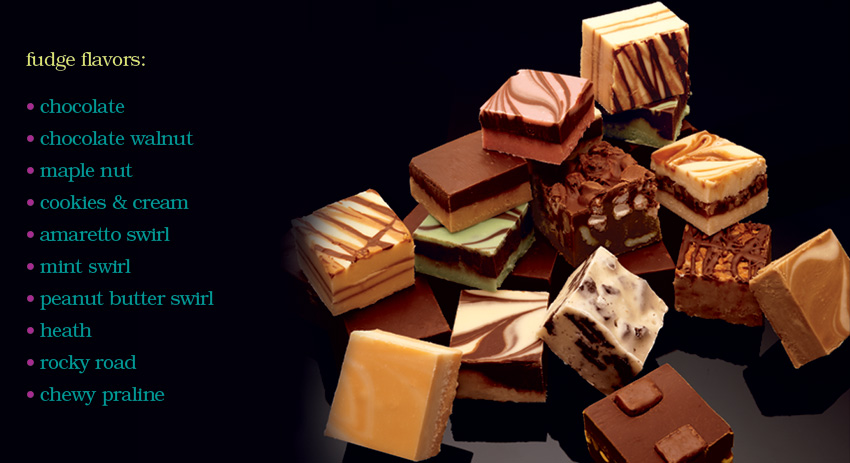 Fudge is a type of confectionery which is made by mixing sugar, butter and milk, heating it to the soft-ball stage at 240 °F (116 °C), and then beating the mixture while it cools so that it acquires a smooth, creamy consistency. Fruits, nuts, caramel, candies, and other flavors are sometimes added either inside or on top. It is often bought as a gift from a gift shop in tourist areas and attractions.
Fudge is a type of confectionery which is made by mixing sugar, butter and milk, heating it to the soft-ball stage at 240 °F (116 °C), and then beating the mixture while it cools so that it acquires a smooth, creamy consistency. Fruits, nuts, caramel, candies, and other flavors are sometimes added either inside or on top. It is often bought as a gift from a gift shop in tourist areas and attractions.

The origin of fudge is unclear, but the history of fudge can be traced back to at least 1886 CE. The exact origin and the inventor of fudge remain disputed, but some experts believe that the word “fudge” was first applied to a botched batch of caramels, prompting the exclamation, “Oh fudge!” Most food historians believe that fudge, as it exists today, is an American invention.
Fudge is a crystalline confectionery. Unlike many other types of candy, such as taffy and caramels, which forgo crystallization, crystal formation is necessary for the creation of fudge. This process creates a candy that is firm yet smooth as the crystals are so small that they do not taste or feel grainy. The fudge mixture, which must contain sugar, butter, and milk, must be properly prepared and cooled in order to create sugar crystals that are just the right size. If the process is not carried out correctly, the crystals will either form too early and become too large or never form at all, resulting in a candy similar to caramel.
The history of fudge may predate the foundation of the U.S., and experts are quick to point out the similarities between fudge and tablet, a Scottish confection. Tablet is first mentioned in The Household Book of Lady Grisell Baillie, which was written between 1692 and 1733 CE.
Emelyn Battersby Hartridge documents the first sale of fudge, writing a letter in 1886 stating that a schoolmate’s cousin had sold fudge for 40 cents per pound in Baltimore. In 1888, Ms. Hartridge, still attending Vassar College in Poughkeepsie, New York, wrote that she made as much as 30 pounds of fudge for the Senior auction. Fudge caught on quickly at Vassar and, before long, recipes for the confection began popping up at other women’s colleges. Smith and Wellesley colleges adapted the so-called original recipe into their own versions.
Vassar’s recipe called for white sugar, cream, unsweetened chocolate, and butter. The Wellesley College creation altered the original recipe only slightly by adding marshmallows, which keeps the fudge from collapsing during cooling. The Smith College recipe was the first to deviate from the original, adding extra butter along with brown and white sugar, molasses, and vanilla. Each of these recipes is notoriously delicate. The history of fudge was forever changed when corn syrup, which delays crystal formation, was first used for foolproof recipes.
Information shared from wiseGEEK
Ashley’s Confectionery creates the finest hand-dipped chocolates, creamy homemade fudge and carries the largest variety of licorice, gummies and old-fashioned candies. Ashley’s homemade fudge is soft, creamy, and the prefect amount of sweet. The highest quality ingredients are used to produce the ideal blend in our copper kettle resulting in 10 irresistible flavors that are sure to satisfy anyone’s craving.


